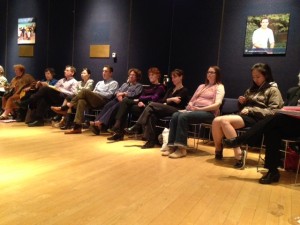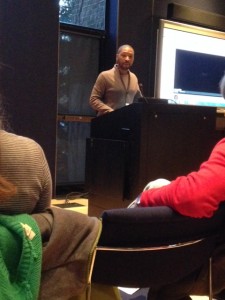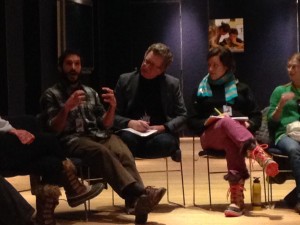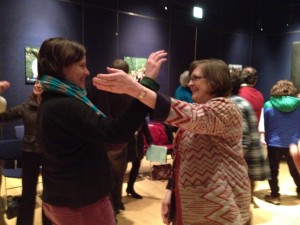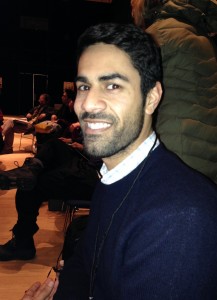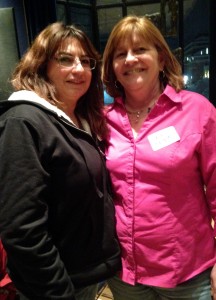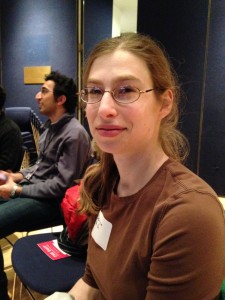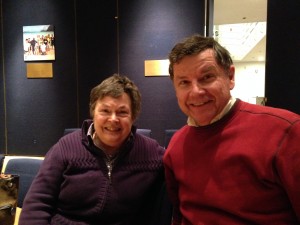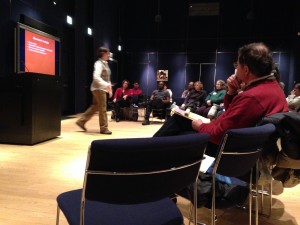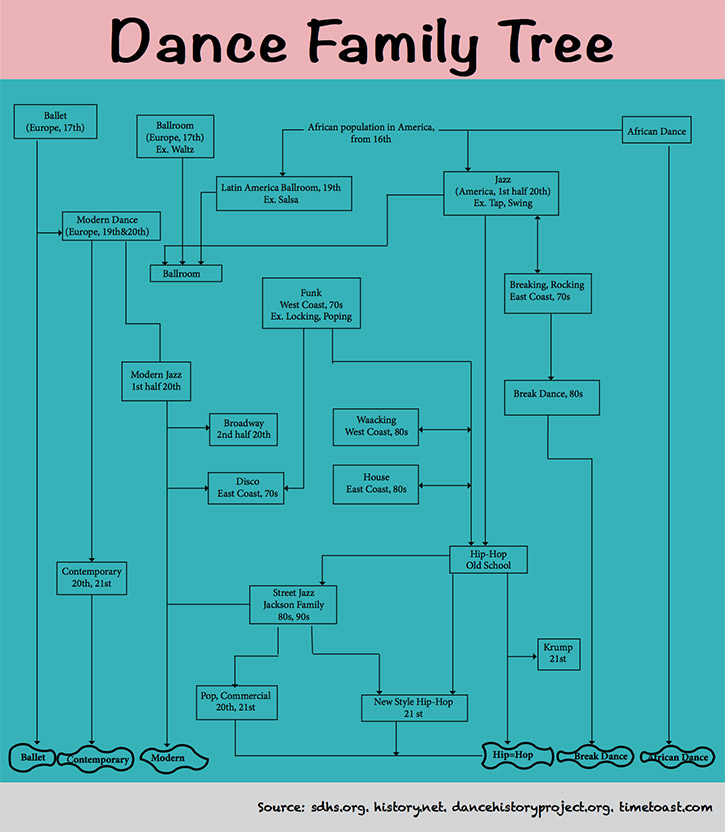UMS Night School: Bodies in Motion – Final Session Recap
Editor’s note: This post is a part of a series of by U-M student Sarah Squillante, who’s covering our free UMS Night School: Bodies in Motion series. Learn along side with them.
UMS Night School celebrated the end to its semester-long series, “Bodies in Motion,” on Monday night with a wrap-up and graduation ceremony.
It started off with a twist on the usual name game – attendees were asked to embody how they viewed dance in a single gesture, after having experienced UMS Night School and dance performances. Responses ranged from falling to the ground to smaller movements borrowed from past performances. The participants were then paired off into groups to create small tableaus of movement.
Host Clare Croft asked attendees to close their eyes and reflect on the many thought-provoking experiences that they have shared: guest lecturers, videos, movement exercises, discussions, and an array of performances. Attendees were asked to share their thoughts on the value of Night School – their expectations, reflections, and memories.
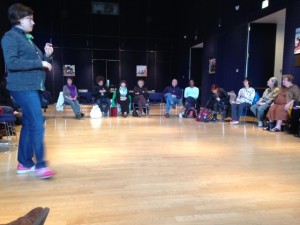
Many weren’t expecting it to be such a fulfilling experience, but developed a true understanding of “how we move and how we develop movement.”
Others were thankful for the opportunity to “experience dance through someone else’s shoes,” and “to see unconventional performances.”
Participant Geoff Smereck expressed gratitude that UMS was able to unite those that have zero dance experience with those who are very knowledgeable: “It was such a privilege to have major artists sit down with us before and after performances. To connect in that way is very special,” he said.
“The presentation [itself was] very unpretentious,” said participant Harvey Pillersdorf. “I came away more invigorated and more curious. It wasn’t just a lecture.”
Attendees enjoyed light refreshments while gift cards were presented for those with “perfect attendance” and raffle tickets were drawn. Everyone was also given a sneak-peak at next season’s dance offerings.
Join us for a complete unveiling at the Season Announcement Party on Sunday, April 13 at 1:00 PM on the 4th floor of the Rackham Building!
Thank you for joining us for Night School this semester – we look forward to another season full of dance engagement next year!
Share questions, comments, or suggestions in the comments below.
UMS Night School: Bodies in Motion – Session 8 Recap
Editor’s note: This post is a part of a series of by U-M student Sarah Squillante, who’s covering our free UMS Night School: Bodies in Motion series. Learn along side with them.
UMS Night School’s 8th session welcomed the largest crowd yet. That’s not too surprising, given the notoriety and accolades of its special guest: award-winning choreographer and dancer Kyle Abraham, winner of the prestigious MacArthur Fellowship and numerous other awards. His work – a dynamic fusion of hip-hop and modern – is often laden with questions of gender, race, poverty, and politics. He is working on creating new works for his company, Abraham.In.Motion, in addition to previous works like Pavement and The Radio Show (excerpts below).
We’re excited to announce that Abraham’s company will be making its UMS debut during our 2014-2015 season (we’ll reveal the details when we launch our 2014-2015 season on April 13, 2014). After quick introductions, the entire session was dedicated to a talk and short discussion detailing Abraham’s personal dance history, influences, and recent works.
Check out some of Abraham’s previous work in the following videos, which were shown during his talk:
U-M Dance Sophomore Elizabeth Benedict (on left in photos below) was encouraged by a professor to attend on Monday night. “I liked the talk because I saw a lot of how I move in his movements [in the videos]. I was inspired because I haven’t been dancing since I was three, and he hasn’t been dancing since he was three either. It was really validating,” she said. “He was really humble about everything.”
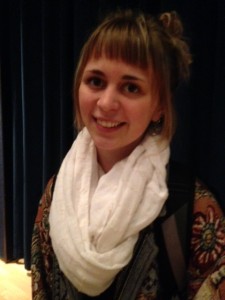
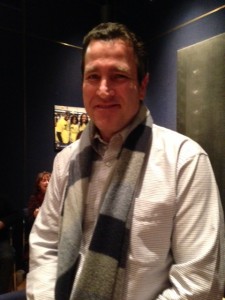
Abraham also attracted those less familiar with modern dance. “I didn’t grow up understanding dance, really,” said second-time attendee and ballroom dancer, Tom (above, on right). “I do a lot of social ballroom dancing, but I come from a music family with lots of visual art and music exposure – never dance.”
Night School is coming to a close! Join us for a recap of the semester and graduation next week, March 31, in the U-M Alumni Center at 7 PM.
Share questions, comments, or suggestions in the comments below.
UMS Night School: Bodies in Motion – Session 6 Recap
Editor’s note: This post is a part of a series of by U-M student Sarah Squillante, who’s covering our free UMS Night School: Bodies in Motion series. Learn along side with them.
“I used to dance when I was a little girl – I have very fond memories of it,” said one UMS Night School attendee. Eddie King decided to come upon a friend’s suggestion, adding that he’d “been to a bunch of performances before and had never heard this stuff.”
It’s clear that everyone is inspired to come to Night School for difference reasons, but all have one thing in common: a curiosity about body movement.
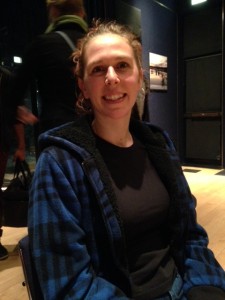
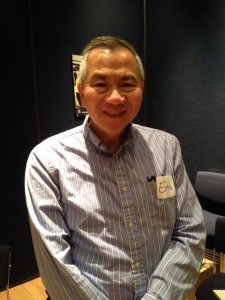
Newcomers Marly Spieser-Schneider and Eddie King share their first impressions on Night School.
On a sunny Monday night, the class was first split up into small discussion groups to tackle a few questions regarding a recent experimental performance created and performed by Jennifer Monson and DD Dorvillier. They watched a short clip from a past performance of RMW (a)/RW and brought up questions regarding intimacy, the impact of lighting, design, and music choices, audience-performer interaction, social commentary, and the strength of the dancers.
UMS director of education and community engagement Jim Leija, who served as substitute teacher in host Clare Croft’s absence, reminded attendees that it was perfectly acceptable to exit the theater and not “get it” – especially in an experimental piece like this one – even if one is a frequent dance performance patron.
Night School attendees were again treated to a panel of an array of experts – this time in the field of music. Melody Racine, U-M Associate Dean for Academic Affairs and Associate Professor of Voice, Joseph Gramley, U-M Assistant Professor of Music and Co-Coordinator of Percussion, and Conductor Yaniv Segal spoke about the movement of the body in orchestral, percussion, and vocal performances in an effort to prepare attendees for the Israel Philharmonic Orchestra on March 15.
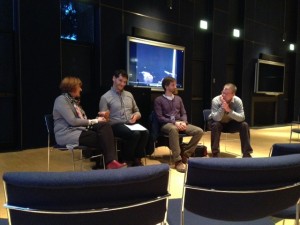
Melody Racine, Jim Leija, Yaniv Segal, and Joseph Gramley discuss body movement in music performance.
Segal began the discussion with a movement exercise intended to convey what exactly a conductor does. The discussion that followed examined the physicality of playing an instrument (and vocal performance), which included the importance of body movement and the necessity of “breath.”
Music performance doesn’t typically get people talking about movement, but attendees were enthusiastic to chat about these genres through the bodies in motion lens. “There was a lot said by the panel that I could identify with as a dancer,” said Marly Spieser – Schneider, a former U-M dance student who was new to Night School. “There’s usually a language barrier between dancers and musicians, and it was nice to hear things that really resonated with me.”
Attendee Geoff Smereck added that Night School has equipped him with a movement vocabulary that transcends performances: “One cross-cutting concept that I’m applying to all performances is harmony,” he said.
For Marly, Night School was a great experience because the discussion didn’t get stuck on one topic for too long. “The first topic could have taken an hour, but it’s good to discuss something and then move on, since some people won’t be able to connect to a particular topic.”
Night School continues at the same time and place on Monday, March 17 at 7 PM in the U-M Alumni Center. The next session – “Dance on Camera” – will focus on creating dance for film. The dance-curious are also invited to check out Gillam dance’s performance of “Sit, Kneel, Stand” at the Berman Center for the Performing Arts on March 12.
Session Resources
- UMS Bodies in Motion Session 6 – Key Theme, Players, and Definitions [Word Document assembled by Marcus White, MFA Candidate – Dance, University of Michigan]
Interested in even more dance engagement? Pick up an adventure card to learn all about the dance activities we’re offering this year and for a chance to win a backstage meet and greet.
Share questions, comments, or suggestions in the comments below.
UMS Night School: Bodies in Motion – Session 5 Recap
Editor’s note: This post is a part of a series of by U-M student Sarah Squillante, who’s covering our free UMS Night School: Bodies in Motion series. Learn along side with them.
Educationally rich. Inspiring. Moving. Authentic. Sharing. These are just a few of the many words UMS Night School attendees provided when asked to summarize their experiences thus far.
“This is making me think so much more deeply about the play,” said Sharman Spieser.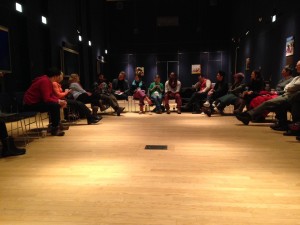
Sharman’s comment was just one among many in a discussion of Théâtre des Bouffes du Nord’s production of The Suit that opened up Monday’s session, led by U-M Professor of Theatre, Jillian Eaton.
Points of reflection concerned the transformation of the play from a short story, the significance of music, the development of the main female character, the subtlety of apartheid undertones, and, of course, movement.
“[Movement] was not a layer that was added on. It was at the core of the performance,” said one attendee.
Host Clare Croft asked attendees how they connected physically with the performance. This was a night school session devoted to Bodies in Motion, after all. Attendees were invited to share how they physically reacted to certain moments, and how they thought they would feel if they were one of the audience members pulled on stage during the audience participation moment in the performance.
“What I’ve learned the most at night school is how movement is a part of everything that you do,” said Lisa Beard.
The session moved to a discussion with this question at its center: What does it mean to experiment in motion? U-M Associate Professor Dance, Amy Chavasse, got bodies moving instead lips, this time using an exercise in which pairs of two walked toward each other, slowly writing their names in the air with a body part. The room buzzed with discussion as soon as the lines collided.
U-M Associate Professor of American Culture, Larry La Fountain-Stokes, emphasized the value in performances that break the dance mold, specifically in regard to the traditional male/female stereotype. One such performance is the upcoming RMW (a)/RW and Toe, performances by DD Dorvillier and Jennifer Monson, performances that came out of a conference called Meanings and Makings of Queer Dance Research. The shows will be performed in the U-M Duderstadt Center Video Studio on North Campus on February. 26 and 27 at 7:30 PM.
The pleasure and value of experimentation was summed up by Clare Croft, who said, “I find that the kinds of performances I like the most are those when I end up saying what’s going on? What’s going on? What’s going on? This is awesome.”
Night School is taking a short break and will resume on Monday, March 10 at 7 PM in the U-M Alumni Center. Our sixth session, entitled “Bodies Make Music,” will delve into the movement of musicians and prepare attendees for the Israel Philharmonic Orchestra.
Interested in even more dance engagement? Pick up an adventure card to learn all about the dance activities we’re offering this year and for a chance to win a backstage meet and greet.
Session Resources
- UMS Bodies in Motion Session 5 – Key Theme, Players, and Definitions [Word Document assembled by Marcus White, MFA Candidate – Dance, University of Michigan]
Share questions, comments, or suggestions in the comments below.
UMS Night School: Bodies in Motion – Session 4 Recap
Editor’s note: This post is a part of a series of by U-M student Sarah Squillante, who’s covering our free UMS Night School: Bodies in Motion series. Learn along side with them.
Does a discussion of theatre belong in a Night School series devoted to dance? Is there a place for opera, on-stage violence, even music? After Monday’s UMS Night School session, most attendees would probably say that it does.
Host Clare Croft reminded attendees that there are multiple ways to enter a performance. Even in theatre, she said, it’s useful to pay attention to movement and ask ourselves: How are performers using the space? What can we learn about the characters from how they move or stand? She introduced four speakers who offered their personal take on the upcoming performance of Théâtre des Bouffes du Nord’s production of The Suit, directed by Peter Brook.
Naomi Andre, U-M Associate Professor of Women’s Studies, explained the significance of South African opera, reminding participants of dance-like qualities of voice performance. UMS Campus Engagement Specialist, Shannon Fitzsimons, spoke about legendary theatrical director Peter Brook, and touched on his “sense of visual economy” and “commitment to emotional truth,” among other details. UMS Director of Programming, Michael Kondziolka, touched on his skepticism before seeing the performance for the first time and his reasons for selecting the piece. He noted that it is really “telling a story about the movement of bodies.” Finally, Rob Najarian, U-M Assistant Professor of Theatre and former fight/violence director, encouraged attendees to think about the “shared experience” between audience and performer. He led a movement exercise that illustrated the deliberate nature of movement.
Attendees also had a chance to reflect on the past weekend’s performances of Compagnie Kafig, demonstrating a movement that embodied the show to share with the group; many found that the troupe had an incredible amount of athleticism and humor.
One attendee noted that her experience at the You Can Dance workshop affected her viewing of Compagnie Käfig: “It wasn’t the type of move that makes you go to your friends and say, ‘wow did you see that?’ but I really noticed the intricacy and complexity in movements that seem so simple,” U-M graduate and frequent Night School attendee Sasha Kapshai said.
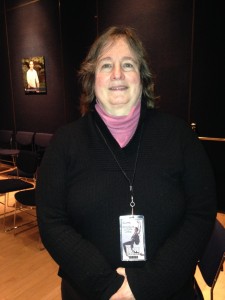
Attendee Jane Michener didn’t have plans to see The Suit before the evening, but then changed her mind. “I’m intrigued by all the intricacies of how it’s put together,” she said.
Session 5 of Night School, Body Experiments, will explore ways in which dancers experiment and create new ideas in dance, preparation for Jennifer Monson and DD Dorvillier’s RMW(a)/RMW, and discussion of The Suit. Special guests include: Anita Gonzalez, U-M Professor of Theatre and Drama, Amy Chavasse, U-M Associate Professor of Dance, Larry La Fountain-Stokes, U-M Associate Professor of American Culture, Gillian Eaton, U-M Assistant Professor of Theatre, and Rob Najarian, U-M Assistant Professor of Theatre.
The upcoming weekend is full of dance-related viewing opportunities! Check out the Dance on Camera Festival at the University of Michigan Museum of Art and the UMS performance of Théâtre des Bouffes du Nord: The Suit, 2/19-2/22 at the Power Center.
Session 4 Resources
- Excerpt from Peter Brook’s The Open Door
Interested in even more dance engagement? Pick up an adventure card to learn all about the dance activities we’re offering this year and for a chance to win a backstage meet and greet.
For a complete list of 2013-2014 dance performances, visit ums.org. Share questions, comments, or suggestions in the comments below.
UMS Night School: Bodies in Motion – Session 3 Recap
Editor’s note: This post is a part of a series of by U-M student Sarah Squillante, who’s covering our free UMS Night School: Bodies in Motion series. Learn along side with them.
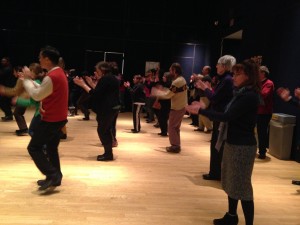
UMS Night School attendees danced to a new beat this week – literally. Midway through the session, attendees were asked to get up on their feet, learn a basic Capoeira step, and then free-style in a large circle to funk music. The movement exercise, led by U-M Dance MFA Candidate Marcus Whiten, gave attendees a kinesthetic taste of a distinct style – a mix of hip hop, martial arts, and acrobatics – that Compagnie Käfig will bring to Ann Arbor this weekend, February 14 and 15.
This week also marked the beginning of a new format in which attendees have the opportunity to discuss a recent dance performance. This week’s discussion centered around “Moving Pictures,” a concert featuring 4 works performed by the U-M department of Dance. In a short panel discussion, three dancers spoke first of the larger ideas that they were asked to conceptualize during the beginning stages of the pieces, then progressed to more specific elements of the performance, like costuming and live music. The dancers expressed delight in the challenges that the pieces provided and in the connections that they were able to make with the audience.
The attendees comprised a diverse a group as usual, ranging from experienced dancers to those who had never seen a performance before. The class has grown significantly since the first week. Some have become Night School “regulars,” while others ventured out into the cold for the first time.
In the left photo, newcomer Razi Jafri said he came because he “didn’t really know anything about dance – artistically or technically,” so he figured it’d be a good introduction.
On the right, Lucie Cohen and Deb Taylor came to Night School thinking they’d be seeing a dance performance, but were pleasantly surprised by the discussion format. “I really enjoyed getting involved when we started moving. The proximity of our bodies made me feel like I knew people on a personal level,” Lucia said.
Leslie Woldenberg, a dance lover and frequent UMS patron, drove all the way from Toledo with a friend to experience Night School for the first time.
The session finished with a short talk from Reighan Gillam, Postdoctoral research fellow in the U-M Department of Afroamerican and African Studies, who spoke about the origins of hip-hop music and dance in Brazil. Gillam emphasized the fact that rappers come from the periphery of Brazil and that, much like hip hop in the United States, the content typically revolves around the violence and system inequality characteristic of marginalized groups.
The details – and the questions they inspired – were intended to help attendees frame their viewing of Compagnie Käfig. Night School host Clare Croft suggested that attendees use information from the lecture to consider how the atmosphere in Brazil may impact the movement they see on stage.
The fourth session of Night School will include an exploration of how actors think about movement, with a preparation for Théâtre des Bouffes du Nord’s The Suit, and also a discussion of Compagnie Käfig’s Correria Agwa. Special guests will include: Naomi Andre, U-M Associate Professor of Women’s Studies, Rob Najarian, U-M Assistant Professor of Theatre, and Michael Kondziolka, UMS Director of Programming. It will be held at the U-M Alumni Center at 200 Fletcher Street at 7 PM.
Session 3 Resources & Readings
- UMS Learning Guide on Compagnie Käfig
- Performance prep reading on Capoeira – “Headspin” by Barbara Browning
- Bodies in Motion Session 3 – Key Themes, Players, and Definitions [Word Document assembled by Marcus White, MFA Candidate – Dance, University of Michigan]
- Session 4 Prep Reading: Excerpt from Peter Brook’s The Open Door
Interested in even more dance engagement? Pick up an adventure card to learn all about the dance activities we’re offering this year and for a chance to win a backstage meet and greet.
For a complete list of 2013-2014 dance performances, visit ums.org. Share questions, comments, or suggestions in the comments below.
Interview: Kelvin Wyatt, Instructor at Tabcat Detroit
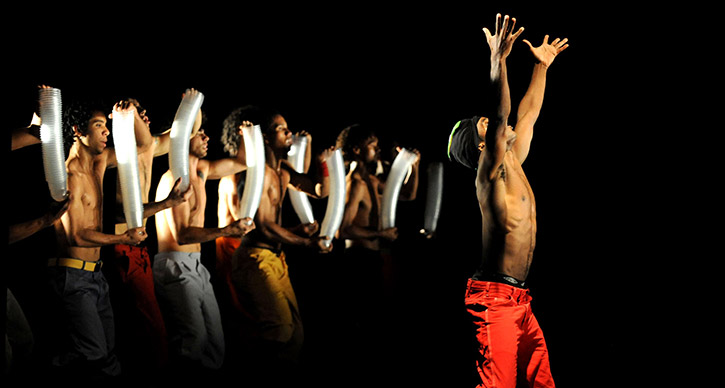
Photo: Compagnie Käfig, a dance company drawing on capoeira, performs in Ann Arbor on February 14-15, 2014. Photo by Michel Cavalka.
Recently, I had the chance to join in on a workshop with Tabcat Detroit, a Detroit-based dance group that teaches and performs a Brazilian folkloric dance called capoeira. We’re presenting Compagnie Käfig, a dance company that’s cross-polinating across genres and incorporating athletic samba, hip-hop, martial arts, capoeira dance, and even acrobatics into their style, on February 14-15, 2014, and we wanted to know more about the capoeira community locally.
As a ballerina, I was out of my element – banging on a drum and straining to mimic the Brazilian chanting – but in awe of what I could only describe as graceful athleticism. I had jumped at the opportunity to explore capoeira firsthand, but now, as the instructor was urging me to show off what I had learned during the hour in the center of the circle, I was feeling a bit apprehensive. My hips had grown sore from all the crouching, and I still wasn’t sure about the sequence of the steps. But as I floated around the room, squatting and kicking and singing, I experienced the elegance in this ancient dance form.
After class, I sat down with the group’s main instructor, Treinel Pequenininho (Kelvin Wyatt), to learn more about capoeira and his specific experiences with the art form.
Sarah Squillante (UMS): What is your background in capoeira?
Kelvin Wyatt: I’ve been training in capoeira for about 16 years. Seven years ago, I started training in traditional Capoeira Angola of Bahia. My interest began in high school, after I saw capoeira for the first time in a movie called Only the Strong. The next day at school, I met this new person named Tadarius in art class. And as I was riding my bike home, I watched somebody doing cartwheels and kicks in front of his house, and I flipped off my bike. When I got up and went over, it turned out to be Tadarius, the same person I had met in art class.
He told me he was training with a group on the west side of Detroit. So from there, I trained and trained. I really believe that the universe made it possible for me to meet Tadarius and give me a means for my journey in capoeira.
I met Mestre Caboclinho, a master in capoeira Angola of Brazil, in 1999 at a workshop that was given at the Serengeti Ballroom in downtown Detroit. In 2007, I came across him again. Mestre Caboclinho emphasized on the complete culture of capoeira, not just throwing kicks. He took me under his wing and helped make me the person I am today in capoeira. I’ve been teaching now since 2009.
SS: Where does capoeira come from? Can you tell me more about the art form?
KW: Capoeira itself is an art that was developed over 500 years ago by Africans in Brazil to celebrate life. The art is a mixture of African and Portuguese influences. Its purpose is to disguise self-defense into a dance and a game. Capoeira combines dance, music, song, acrobatics, and philosophy.
Acrobatics, in itself is a test of individuals, their capacity, what they can actually do inside of capoeira. Everybody has thought of that word, fear. But in capoeira, you don’t have fear anymore because it helps you let it go.
SS: Do you think capoeira is more of a dance or a martial art?
KW: For me, dance. I say dance because most of the time, especially for Americans, when people hear martial art, they always think fight fight fight, but the philosophy and everything inside of capoeira is that the strength is there, but you need to know your patience.
Even in the self-defense aspect, it’s all a game. If you have someone come to you and they’re using all their strength, it just knocks you off your feet. But if you move out of the way, it’s surprising. The attacker thinks, wait he’s escaping? He’s swaying out of the way? How did he do that? He did it again. Now I’ve let you fall into my game. Now I smile. In capoeira, we always smile. And then it’s like: Why is he smiling now? It’s capoeira.
SS: What makes capoeira challenging?
KW: I look at it as growth. It might be a challenge to people if they’ve never done an acrobatic move before, if they’ve never done a cartwheel or spoken a different language before. But with that in mind, if you have the capacity to learn, it’s not going to be a challenge.
SS: What makes it rewarding?
KW: What makes it rewarding is that we all have one goal. One goal may be to want to learn how to do a cartwheel, or to play all eight instruments. You set these goals, and these goals enrich life because capoeira teaches a lot about life. Some people come with really bad road rage. Capoeira helps them calm down. Some people just want a work out.Ccapoeira helps them work out. It touches everybody in a different way.
SS: Does Tabcat Detroit perform?
KW: Other than teaching regular capoeira classes, we do performances as well. This year, we performed for the Detroit Tigers, during Fiesta Tigre, at the main entrance to Comerica Park. There were thousands and thousands of people. What is this? They spin on their head, they do this, they jump in the air, they do no-handed cartwheels. capoeira – it’s here in Detroit. We’ve also performed for the College of Creative Studies, and at the University of Michigan, at an annual performance that we do for one of the professors. We’ve done a performance for the Kwanzaa celebration at the Charles H. Wright Museum in downtown Detroit as well.
SS: The movements are so graceful that they almost seem pre-choreographed.
KW: Capoeira is supposed to be natural. You have some people that practice capoeira as a choreographed art. They give each other signals. But traditional capoeira – the capoeira Angola that we teach – has more philosophy, more understanding.
SS: How has capoeira impacted the Detroit community?
KW: Everybody just looks at Detroit as far as the negative, not the positive. Granted, there are a lot of neighborhoods going down and things like that, but there are actual people in the city that do care. The work that I (and the people before me) have done for 14 years is to bring capoeira here so everybody could be happy.
I have seen it make the angriest person smile. I have seen it make someone cry. I have seen people take what they thought they couldn’t do and change it into something they could do. This has helped people learn that the tools are actually there.
I’ve seen it bring communities together. We’ve done performances where we play the berimbau [bow-like instrument] and batucada [a percussive, African-influenced Brazilian style of samba] through actual neighborhoods. People come out and they’re like: What’s that?
SS: How has capoeira impacted your life personally?
KW: Capoeira has helped me look at a lot of things that I thought were impossible and I find out that they are possible. It made me step out of my shell. It helped me realize I have something inside of me that I can share with everybody else. Something that can actually help people.
SS: Is there anything else you want to share with me about capoeira or your experiences?
KW: Well there’s one main aspect that my teacher always touched on: capoeira can – like I said – make the angriest person nice. Most people feel that when you do a kick, the kick is how you show strength. But in capoeira it’s in reverse. Who can make a beautiful game? Who can actually give a question and an answer? Are you going to respond strong, and get the person to fall? Or are you going to bring harmony to the game? That’s true capoeira – harmony. The self-defense is there. You know when to open your toolbox and use it. But other than that, it’s just enjoying it. Do something that’s healthy for you, not just for your body but your spirit.
To learn more about Tabcat Detroit, visit http://detroitcapoeira.com/.
On Feb. 14 and 15 at the Power Center, UMS will welcome Compagnie Käfig, a French-based group that draws heavily upon capoeira. For more information and tickets, visit ums.org.
UMS Night School: Bodies in Motion – Session 2 Recap
Editor’s note: This post is a part of a series of by U-M student Sarah Squillante, who’s covering our free UMS Night School: Bodies in Motion series. Learn along side with them.
What is dance? A rhythmic movement? Deliberately choreographed steps? Expression through time and space? What makes someone a good dancer?
This week’s UMS Night School session, held on Monday night, attempted to answer these tough questions and sparked a litany of others. It also welcomed its first guest speaker: U-M associate professor of Movement Science in the School of Kinesiology, Melissa Gross. Gross spoke about her research regarding the relationship between emotion and movement. Her area of study has focuses on mostly pedestrian movements, which have been found to correlate strongly with emotion. “Your emotions impact your body movement and your body movement can impact your emotions, too,” Gross said.
Attendees were invited to conceptualize movement a bit more scientifically, but this invitation quickly inspired questions that carried over to the dance world: How do we account for cultural differences in movement? Are certain people more in tune to others’ emotions (as expressed through movement) than others?
UMS Night School host, Clare Croft (assistant professor of dance at U-M), reminded everyone that this notion can be found everywhere in dance – Martha Graham’s work, for instance, was focused on the idea of translating emotion through motion in a universally accessible way.
Rebecca Rebhuhn (photo left), a U-M Graduate Student in mathematics, was a newcomer: “There aren’t many dance events in Ann Arbor, so I go to all that I can. I used to study dance academically and figured this could be interesting,” she said. Others were back for their second week.
Attendees Susan and Geoff Smereck (photo right) have seen numerous UMS dance performances together. They describe themselves as being “exuberant about dance. “Focusing on movement like we have allows me to not focus so much on the lack of a story line,” said Susan. “[Night School is] prying my brain open and giving me ways of thinking about movement.” Geoff wasn’t surprised by the thought-provoking nature of the evening’s discussions. “This is so U of M,” he said. “I’m looking for the vocabulary to conceptualize the dance performances that I see.”
PhD student Payam Mirghams and U-M graduate Sasha Kapshai share what inspired them to come to Night School.
The session, which was held the day after the Super Bowl, ended with a fitting video of former U-M quarterback Denard Robinson in action. Attendees were asked to describe the movement of football, and then to consider what we could learn from a culture or an idea through this movement.
Night School host Clare Croft demonstrates differences in movement.
Next week’s Night School, “Technique, Virtuosity, and Monsters,” will include a discussion of Moving Pictures, the upcoming U-M Department of Dance performance, and an introduction into hip-hop – just in time for Compagnie Käfig’s Correria Agwa on February 14 and 15. Special guests will include Reighan Gillam, a Postdoctoral research fellow in the U-M department of Afroamerican and African studies, and several U-M Dance Graduate Students. It will once again be held at the U-M Alumni Center at 200 Fletcher Street.
Session 2 Resources for Download
Session 3 prep reading on Capoeira – “Headspin” by Barbara Browning
Session 2 Powepoint Presentation by U-M Assistant Professor of Dance Clare Croft
Interested in even more dance engagement? Pick up an adventure card to learn all about the dance activities we’re offering this year and for a chance to win a backstage meet and greet.
For a complete list of 2013-2014 dance performances, visit ums.org. Share questions, comments, or suggestions in the comments below.
UMS Night School: Bodies in Motion – Session 1 Recap
Editor’s note: This post is a part of a series of by U-M student Sarah Squillante, who’s covering our free UMS Night School: Bodies in Motion series. Learn along side with them.
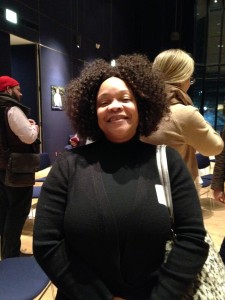
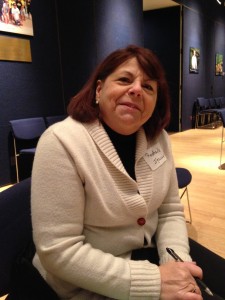
Lisa Beard (Left) and Rochelle Igrison (Right) are both enthusiastic to expand their dance knowledge.
UMS Night School isn’t designed to be a dance class, but the first session got people moving just enough to start to think differently about movement. Community members of all ages and backgrounds stood in a semi-circle in the chilly University of Michigan Alumni Center on Monday night, introducing themselves not just with names but an accompanying gestures.
Clare Croft, assistant professor of dance at the University of Michigan who’ll lead Night School this season, asked what the exercise made everyone think of and what images came to mind when they heard the word “dance.”
One attendee noticed that when the participants were asked to omit their names from the introduction, the gestures were a lot easier to understand and remember, and another suggested that movements can “characterize people and carry meaning.”
Jim Leija, director of education and community engagement with UMS, welcomed participants and said that Night School is an opportunity to “improve our comfort level with dance and make room for a reflective moment.” He emphasized that the program would not be a lecture series, but rather an interactive experience. The first session didn’t disappoint. Participants stretched out their arms in various ways and explored the ways in which even simple movement – like rubbing hands together – can be executed in many ways. Many were eager to suggest topics that they hoped to address in the coming weeks, like why we prefer certain performances over others and how dance evokes political messages.
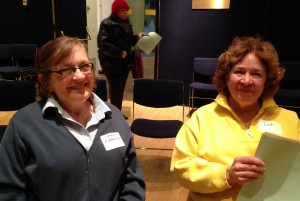
Pat Bantle (Right) is a return night-school student. “I love dance,” she said. “I came last year and I enjoyed it very much.”
Some of the participants seemed excited to engage with a medium that they already love. Lisa Beard drove all the way from Oak Park to participate. “I just turned 50 and I promised myself I’d do things I’d never done before,” she said. A longtime patron of the arts, Beard is excited to meet new people. Rochelle Igrison explained that she’s been to all of the UMS dance performances thus far. “I may not have a dancer’s body, but I can still be a patron of the arts,” she said. “I just love dance.”
Others were more explicit in what they hoped Night School would do for their engagement with the arts. Art, a frequent UMS concert goer, said he was eager to expand his dance vocabulary in order to engage in conversations after performances. “I want to be able to talk about it,” he said.
Croft showed a series of videos that touched on a breadth of dance styles and considerations, from Martha Graham’s Lamentations to a video from the 2008 Beijing Olympics. She suggested, in her parting thoughts, that participants use the sessions not only to “define what dance is, but what it does.”
Next week’s Night School, “Moving Pictures,” will welcome a U-M professor of Movement Science and a professor of Art and Design. It will again be held at the U-M Alumni Center at 200 Fletcher Street. Interested in even more dance engagement? Pick up an adventure card to learn all about the dance activities we’re offering this year and for a chance to win a backstage meet and greet!
Download Sesssion 1 Resources, including key concepts, videos, and vocabulary from the first session [Word Document assembled by Marcus White, MFA Candidate – Dance, University of Michigan]: Bodies in Motion Session 1 Key Themes, Players, and Definitions
For a complete list of 2013-2014 dance performances, visit ums.org. Share questions, comments, or suggestions in the comments below.
What do Street Dance and Ballet have in common?

Photo: Compagnie Käfig performs Correria Agwa. They perform in Ann Arbor on February 14-15, 2014. Photo by Michel Cavalca.
Stand a ballerina and a break-dancer side by side and the differences are obvious – pointe shoes versus high tops. One might plié while the other may isolate an arm like a robot. Ask someone to describe the difference between performance dance (also known as concert dance) and street dance, and you’d probably receive a confident response: The first kind of dancer performs and the other dances informally, for passers-by and friends. But the distinction between these two genres may not be so clear, even for the dancers themselves.
Perhaps the terms may be to blame for this confusion. If we take them strictly at face value, we’d expect performance dancers to be performing (presumably on a stage of some kind) and street dancers to be dancing on a street somewhere. But while most ballerinas aren’t pirouette-ing in alleyways, there is a large concert-dance component to street dance. Even if street dancers hone their craft in a club, in a dance hall, or on the street somewhere, they still perform for an audience.
Compagnie Käfig, for example, is a dynamic France-based company that incorporates athletic samba, hip-hop, martial arts, capoeira dance, and even acrobatics into their style. Director and choreographer Mourad Merzouki and the dancers have been highly influenced by many styles that evolved “on the streets,” but they’ve incorporated them into choreography that is performed for an audience in a performance venue setting. Their moves, while likely pre-staged and pre-choreographed, have an air of improvisation and innovation. These moves, while perfected in the studio, may have been created through informal social interactions or collaboration in the regions where the styles originated. Compagnie Käfig dancers seem to combine characteristics of both street and performance dance.
Street dance, then, can better be defined as a reference to dance styles rather than as a description of where the dancing takes place. These styles, like b-boying, break-dancing, and even the Charleston, while taught in studios and performed on stages, evolved outside of the classroom – in nightclubs, at raves, at block parties, on the school yard, and yes, you guessed it – on the street. People who practiced these dances did not initially call themselves “street dancers,” but instead Bboys, lockers, breakers, or funkstylers. The styles were improvisational, and encouraged interaction with audience members and between the dancers themselves. The term “street dance” came along later when these dances were popularized in the 1980s.
Today, the terms “street dance” and “hip-hop dance” are often used to refer to a studio-based version of the styles, which, like the original street dances, are less defined than their performance-based counterparts. They are sometimes improvisational, but can also include choreographed steps.
Concert dance, on the other hand, is a style whose origins are a bit clearer. Ballet (likely the oldest of concert dances) emerged in the Italian Renaissance courts in the 15th century and evolved in its style as it spread to France and Russia. Today, its steps are entirely in French. Ballet is considered by most as the base of all concert dance styles (like jazz, modern, or contemporary), since it provides the foundational techniques used in many different genres. In fact, it is rare to find a professional dancer who hasn’t been trained in one of ballet’s styles. It’s not surprising that ballet originated as and remains a style of dance that is performed formally for a larger audience – pointe shoes demand special flooring, and partnering between male and female dancers requires pre-planned choreography rather than improvisation. The mimes and steps of classical ballet seem to have been created for the purpose of story-telling, and the tradition has remained alive.
When I think of the distinction between these two genres, I can’t help but envision Julia Stiles as she transforms from leotard-clad ballerina to hip-hop dancer in Save the Last Dance. Iconic dance movies like this one – which are for many people the only window into the dance world – may help us visualize the differences between performance and street dance, no matter how stereotypical they may be.
Movies like Step Up, Stomp the Yard, and Honey, the plots of which focus primarily on street dance, are wildly popular with a mainstream audience (as evidenced by their many sequels). Performance dance, while less popular, has surprisingly been the subject of a few mainstream titles like Black Swan and Center Stage, two movies that, while very different, hold a special place in my heart. These films tell the stories of the rigorous world of professional ballet, but even they aren’t devoid of a street dance influence – both films include that popular dancing-at-the-bar-as-relief motif.
What these films hint at is common in contemporary dance. Companies like Compagnie Käfig cross-over and cross-pollinate from various influences regularly. Is it possible that we all have something to gain from Channing Tatum in Step Up?
Interested in learning more? Check out our UMS Adventure Club: Dance, a game designed to reward your inquisitive instincts with the chance to win a special backstage meet and greet with a UMS artist.


